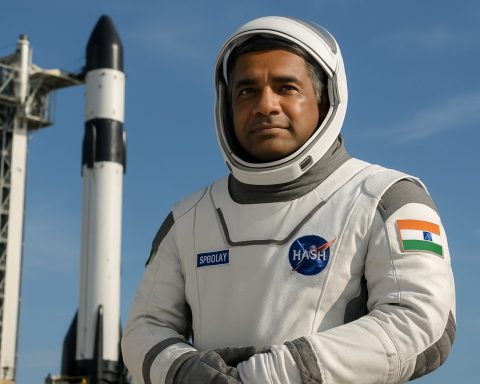- Wing Commander Shubhanshu Shukla of the Indian Air Force is set to be the first Indian astronaut aboard the International Space Station (ISS) via the Axiom-4 mission.
- The mission highlights India’s growing involvement and expertise in space exploration.
- Shukla’s mission includes the Voyager Tardigrades project, which investigates the resilience of tardigrades in space.
- Tardigrades, known for surviving extreme conditions, are studied to understand their resistance to space environments.
- Research aims to uncover insights into DNA protection and repair, crucial for protecting astronauts during long space missions.
- Findings may inform the Indian Space Research Organisation’s (ISRO) upcoming Gaganyaan Mission and human space exploration strategies.
- India’s astrobiology research combines scientific discovery with practical applications for space exploration beyond Earth.
Amidst the cosmic ballet playing out miles above Earth, India embarks on an ambitious journey that not only pushes the boundaries of what is scientifically possible but also celebrates a moment of national pride. Wing Commander Shubhanshu Shukla, Group Captain in the Indian Air Force, prepares to steer the SpaceX Dragon spacecraft to the International Space Station (ISS) as part of the Axiom-4 mission. This momentous occasion marks him as the first Indian astronaut to live and work aboard the space station—a testament to India’s growing prowess in space exploration.
But the mission’s intrigue extends beyond its human protagonist. Shukla carries with him tiny creatures of extraordinary resilience: tardigrades, often called water bears or moss piglets. These microscopic marvels, measuring a mere 0.3 to 0.5 millimeters, are almost indestructible. They thrive in environments as diverse as the mossy floors of forests, the depths of the ocean, and even the frozen realms of polar ice. Yet, it is their ability to withstand the harsh conditions of space that captivates the scientific community.
India’s experiment on the ISS will focus on the Voyager Tardigrades project, one of seven pioneering studies envisioned for this mission. The objective: to investigate how these durable micro-animals can withstand and adapt to the extremes of space. Observing their ability to revive, lay and hatch eggs, and exhibit unique gene expression patterns in a zero-gravity environment could offer profound insights into biological resilience.
Examining tardigrades in the space environment serves more than curiosity. The findings could revolutionize our understanding of DNA protection and repair—an essential knowledge set for safeguarding astronauts against heightened radiation on long-duration missions, such as those to Mars or beyond. The little water bears might just hold the keys to enhancing human survivability in the cosmos.
Moreover, as ISRO gears up for its ambitious Gaganyaan Mission, these investigations into tardigrade biology could inform strategies designed to preserve biological materials or even humans during lengthy voyages through the void of space.
In embracing this frontier, India’s foray into astrobiology does not solely aim at scientific discovery but also at leveraging nature’s ingenuity to propel human exploration beyond the confines of Earth. As Commander Shukla pilots his way into the annals of history, the lessons gleaned from water bears may well chart the course of humanity’s cosmic journey.
Unveiling the Cosmic Voyage: India’s Space Endeavor Through the Eyes of Tardigrades
The Role of India in Space Exploration
India has been steadily making its mark in the global space arena, with key missions like Chandrayaan and Mangalyaan already under its belt. The launch of Wing Commander Shubhanshu Shukla aboard the SpaceX Dragon spacecraft is a significant milestone, placing India at a vantage point in international space exploration collaborations. The Axiom-4 mission embodies the spirit of joint ventures, innovation, and technological prowess, reflecting India’s commitment to widening its spacefront.
Tardigrades: Resilient Pioneers in Space Research
Real-World Use Cases
– DNA Repair Understanding: Tardigrades have unique proteins that protect their DNA from radiation damage. Researching their mechanisms could potentially lead to breakthroughs in radioprotection for astronauts.
– Cryopreservation Potential: The ability of tardigrades to survive freezing conditions hints at advancements in preserving biological samples or even human tissues for future space missions.
– Longevity Studies: By studying gene expression in tardigrades, scientists can explore aging and longevity, potentially leading to aging-related disease interventions.
Market Forecasts & Industry Trends
Given the increasing interest in human space exploration, the market for biotechnological innovations that enhance human survivability in space is growing. The space biology market, which was valued at approximately $15 billion in 2022, is expected to reach about $25 billion by 2030. This growth is propelled by the need for advanced life support systems and biotechnology research, such as that involving tardigrades, to support extended space missions.
Pressing Questions & Answers
How do tardigrades survive extreme conditions?
Tardigrades can endure extreme conditions by entering a cryptobiotic state, where their metabolic activity shuts down. This state effectively makes them immune to harsh environments, including the vacuum of space.
How can tardigrades impact future space missions?
By analyzing how tardigrades protect their cells from radiation and dehydration, scientists could develop similar protective techniques for human tissues, enhancing astronaut safety on long missions.
What is India’s next step in space exploration?
Aside from missions like Axiom-4, India is preparing for its Gaganyaan Mission, aiming to send humans to space using its own capabilities. These experiments with tardigrades could provide vital insights into ensuring astronaut safety on such missions.
Actionable Recommendations
– Stay Informed: Follow credible sources like the Indian Space Research Organisation to keep updated on new findings related to space biology and India’s space missions.
– Explore Educational Resources: Engage with educational programs and documentaries about astrobiology to deepen understanding.
– Connect with Space Enthusiasts: Join online communities focused on space exploration to exchange ideas and learn from experts and enthusiasts alike.
Conclusion
India’s bold initiatives, such as the Axiom-4 mission, not only showcase national pride but also lay foundational work for future exploration beyond Earth. By examining the resilience of tardigrades, scientists are exploring possibilities that might one day bolster human travel to Mars and beyond. As Wing Commander Shubhanshu Shukla ventures into space, the lessons from these microscopic pioneers may steer the course of humanity’s journey through the cosmos.
For more information, you can explore the official ISRO website.








